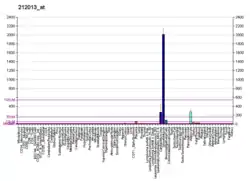PXDN
Peroxidasin homolog is a protein that in humans is encoded by the PXDN gene.[5][6][7]
Peroxidasin requires ionic bromine as a co-factor, making bromine an essential element for human life.[8]
Clinical significance
Mutations in PXDN are associated with microphthalmia.[9]
References
- GRCh38: Ensembl release 89: ENSG00000130508 - Ensembl, May 2017
- GRCm38: Ensembl release 89: ENSMUSG00000020674 - Ensembl, May 2017
- "Human PubMed Reference:". National Center for Biotechnology Information, U.S. National Library of Medicine.
- "Mouse PubMed Reference:". National Center for Biotechnology Information, U.S. National Library of Medicine.
- Horikoshi N, Cong J, Kley N, Shenk T (Sep 1999). "Isolation of differentially expressed cDNAs from p53-dependent apoptotic cells: activation of the human homologue of the Drosophila peroxidasin gene". Biochem Biophys Res Commun. 261 (3): 864–9. doi:10.1006/bbrc.1999.1123. PMID 10441517.
- Nagase T, Seki N, Ishikawa K, Ohira M, Kawarabayasi Y, Ohara O, Tanaka A, Kotani H, Miyajima N, Nomura N (May 1997). "Prediction of the coding sequences of unidentified human genes. VI. The coding sequences of 80 new genes (KIAA0201-KIAA0280) deduced by analysis of cDNA clones from cell line KG-1 and brain". DNA Res. 3 (5): 321–9, 341–54. doi:10.1093/dnares/3.5.321. PMID 9039502.
- "Entrez Gene: PXDN peroxidasin homolog (Drosophila)".
- McCall AS, Cummings CF, Bhave G, Vanacore R, Page-McCaw A, Hudson BG (June 2014). "Bromine is an essential trace element for assembly of collagen IV scaffolds in tissue development and architecture". Cell. 157 (6): 1380–92. doi:10.1016/j.cell.2014.05.009. PMC 4144415. PMID 24906154.
- Choi A, Lao R, Ling-Fung Tang P, Wan E, Mayer W, Bardakjian T, Shaw GM, Kwok PY, Schneider A, Slavotinek A (2014). "Novel mutations in PXDN cause microphthalmia and anterior segment dysgenesis". European Journal of Human Genetics. 23 (3): 337–41. doi:10.1038/ejhg.2014.119. PMC 4326713. PMID 24939590.
Further reading
- Weiler SR, Taylor SM, Deans RJ, Kan-Mitchell J, Mitchell MS, Trent JM (1994). "Assignment of a human melanoma associated gene MG50 (D2S448) to chromosome 2p25.3 by fluorescence in situ hybridization" (PDF). Genomics. 22 (1): 243–4. doi:10.1006/geno.1994.1374. hdl:2027.42/31471. PMID 7959781.
- Mitchell MS, Kan-Mitchell J, Minev B, Edman C, Deans RJ (2000). "A novel melanoma gene (MG50) encoding the interleukin 1 receptor antagonist and six epitopes recognized by human cytolytic T lymphocytes". Cancer Res. 60 (22): 6448–56. PMID 11103812.
- Xu YC, Wu RF, Gu Y, Yang YS, Yang MC, Nwariaku FE, Terada LS (2002). "Involvement of TRAF4 in oxidative activation of c-Jun N-terminal kinase". J. Biol. Chem. 277 (31): 28051–7. doi:10.1074/jbc.M202665200. PMID 12023963.
- Brandenberger R, Wei H, Zhang S, Lei S, Murage J, Fisk GJ, Li Y, Xu C, Fang R, Guegler K, Rao MS, Mandalam R, Lebkowski J, Stanton LW (2005). "Transcriptome characterization elucidates signaling networks that control human ES cell growth and differentiation". Nat. Biotechnol. 22 (6): 707–16. doi:10.1038/nbt971. PMID 15146197. S2CID 27764390.
- Kimura K, Wakamatsu A, Suzuki Y, Ota T, Nishikawa T, Yamashita R, Yamamoto J, Sekine M, Tsuritani K, Wakaguri H, Ishii S, Sugiyama T, Saito K, Isono Y, Irie R, Kushida N, Yoneyama T, Otsuka R, Kanda K, Yokoi T, Kondo H, Wagatsuma M, Murakawa K, Ishida S, Ishibashi T, Takahashi-Fujii A, Tanase T, Nagai K, Kikuchi H, Nakai K, Isogai T, Sugano S (2006). "Diversification of transcriptional modulation: large-scale identification and characterization of putative alternative promoters of human genes". Genome Res. 16 (1): 55–65. doi:10.1101/gr.4039406. PMC 1356129. PMID 16344560.
This article is issued from Wikipedia. The text is licensed under Creative Commons - Attribution - Sharealike. Additional terms may apply for the media files.





